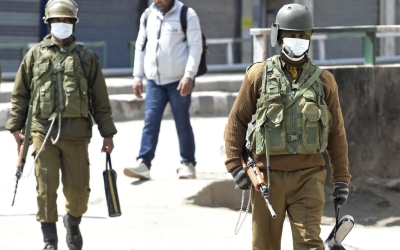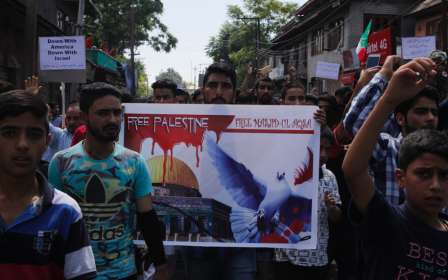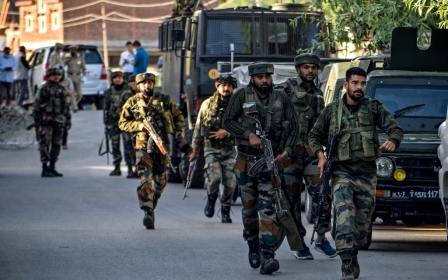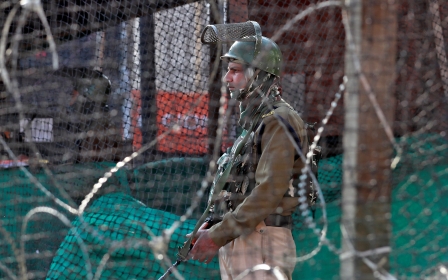In Kashmir, like Palestine, tourism glosses over reality of occupation

Last month, the administration in Kashmir’s Srinagar district announced a stringent lockdown after a surge in coronavirus cases. Pictures emerged of the city centre, Lal Chowk, and other areas being barricaded to enforce the lockdown. Other districts revised their guidelines to deal with the spreading pandemic, with local visitors to Pahalgam being directed to vacate the area within hours.
The administration of Jammu and Kashmir issued an order announcing the reopening of the valley to tourists from 14 July in a “phased manner”. But as the coronavirus outbreak worsened further, a valley-wide lockdown was imposed on 22 July; no rationale was given as to why the lockdown applied only to locals, and not to tourists.
As the battle against Covid-19 continues and residents remain unable to access public spaces, how does it make sense to open these spaces to tourists? This has invited scepticism from the local population over the administration’s containment measures, ostensibly aimed at ensuring public health and wellbeing.
Masking settler-colonialism?
The promotion of tourism is reminiscent of the ways in which Israel uses tourism in the occupied Palestinian territories to “prettify the image of the colonies and the occupation”. But in contrast to apartheid tourism in Palestine, which aims to mask settler-colonialism with the facade of the hospitality of “beautiful” Israeli settlements, in Kashmir, it is primarily built on the narrative of being the backbone of Kashmir’s economy and of strengthening the perception of Kashmir as the “territory of desire”.
In both cases, the real idea is to use tourism as a political propaganda tool to normalise the occupation.
For Kashmiris, this promotion of their homeland as a 'paradise' is a reminder of all the buds that were snatched before they could bloom
In Kashmir, the tourist inflow promotes a sense of normalcy, even as the everyday lives of Kashmiris are marked by the violence of an all-pervasive occupational machinery.
Tourists see the snow-capped mountains and serene waters, the shikara rides on Dal Lake and rafting in Pahalgam; what is hidden are the scores of Indian soldiers patrolling Kashmir’s streets, aiming guns from the bunkers that dot the landscape.
Similarly, Israel’s separation wall, which regulates Palestinian lives and land, draws “graffiti tourists” thronging to click pictures, while ignoring the violence of the structure and how it dehumanises Palestinians.
After the strict curfew and communications blackout implemented in Kashmir in August 2019, the Indian state invited diplomats from various countries to visit amid widespread criticism over its actions in Kashmir. Dubbed “rent-a-diplomat Kashmir tours”, these choreographed meetings aimed to promote the normalcy narrative, even as average Kashmiris totally disappeared from the landscape.
Staking a claim
Last month, the annual Hindu pilgrimage, Amarnath Yatra, to Kashmir was suspended amid a spike in coronavirus cases. The pilgrimage, supported by the state, has had a detrimental impact on Kashmir’s fragile ecology. A study by the Jammu Kashmir Coalition of Civil Society highlighted the militarised nature of this pilgrimage, its “politico-religious” nature and how it is used by India as a tool to stake a claim over Kashmir.
In 2008, the Indian state made an attempt to seize 100 acres of forest land under the auspices of the pilgrimage, essentially seeking to dispossess locals and initiating a summer of bloodshed. That year, 157 civilians were killed, including in the widespread protests following the seizure move.
The way the pilgrimage has been facilitated over the years portrays the Kashmiri “other” as violent and expendable, seeking to erase their culture and exert control over their spaces.
As one Kashmiri researcher has argued, visiting Kashmir is a nationalist pilgrimage for the Indian tourist, shoring up the notion of Kashmir as an integral part on India. Amid India’s settler-colonial policies, tourism is a way to assert ownership over Kashmir.
In the four months following the August lockdown last year, a conservative estimate noted that the economy of Kashmir suffered losses worth 15,000 crore ($2bn), stifling local businesses.
During the current lockdown, the tourism department released a draft houseboat policy seen as a death blow to the industry. Operators have called it “draconian and harsh” with regards to both its timing and the deadlines for meeting certain requirements.
A crumbling economy allows the state further control over the territory. The promotion of tourism in a militaristic state sustained on violence framed as “helping” local Kashmiri livelihoods is just another part of the Indian state’s false narrative.
Crumbling healthcare system
As the world battles a pandemic, opening Kashmir to tourists reveals the Indian state’s urge to control the narrative and to remove the agency of the local population. Kashmiris are dehumanised through lockdowns and movement restrictions, while tourists are welcomed.
Doctors have expressed concerns over the severity of cases and the healthcare system’s lack of capacity to cope. The tourism decision will only heap more pressure on a system already close to crumbling. As coronavirus cases continue to rise, hospitals have reached their capacity, running out of beds.
While tourism is important, it is not central to Kashmir’s survival. Under a violent occupation, the promotion of tourism merely furthers state propaganda.
The Indian state has for decades employed varied means to curb Kashmiris’ struggle for self-determination. The use of tourism as part of this strategy is exploitative, furthering the state’s colonisation, and commodifying Kashmiri culture, while hiding the violence against and resistance of the people.
The Indian state boasts of successful tulip festivals and of multiple other sights to behold in Kashmir; yet for Kashmiris, this promotion of their homeland as a “paradise” is a reminder of all the buds that were snatched before they could bloom - of the dead eyes of people hit by pellets; of the thousands of disappeared roses.
Kashmir is not a spectacle that occupation tourism can gloss over. It is a daily struggle for a life of dignity and freedom from a violent, dehumanising military occupation.
The views expressed in this article belong to the author and do not necessarily reflect the editorial policy of Middle East Eye.
Middle East Eye propose une couverture et une analyse indépendantes et incomparables du Moyen-Orient, de l’Afrique du Nord et d’autres régions du monde. Pour en savoir plus sur la reprise de ce contenu et les frais qui s’appliquent, veuillez remplir ce formulaire [en anglais]. Pour en savoir plus sur MEE, cliquez ici [en anglais].






